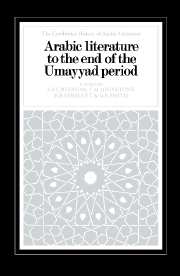Book contents
- Frontmatter
- Contents
- Editorial introduction
- 1 The tribes of pre-Islamic Arabia
- 2 The Umayyad Empire, c. A.D. 750
- 1 Background topics
- 2 Pre-Islamic poetry
- 3 Early Arabic prose
- 4 The beginnings of Arabic prose literature: the epistolary genre
- 5 The role of parallelism in Arabic prose
- 6 The Qur'ān-I
- 7 The Qur'ān–II
- 8 Qiṣaṣ elements in the Qur'ān
- 9 Aspects of the Qur'ān today
- 10 Ḥadīth literature–I: The development of the science of Ḥadīth
- 11 Ḥadīth literature-II: Collection and transmission of Ḥadīth
- 12 Shī'ī Ḥadīth
- 13 Narrative elements in the Ḥadīth literature
- 14 European criticism of Ḥadīth literature
- 15 The impact of the Qur'ān and Ḥadīth on medieval Arabic literature
- 16 The Maghāzī literature
- 17 The Sīrah literature
- 18 The poetry of the Sīrah literature
- 19 Fables and legends in pre-Islamic and early Islamic times
- 20 Umayyad poetry
- 21 Music and verse
- 22 The Greek impact on Arabic literature
- 23 The Persian impact on Arabic literature
- 24 The Syrian impact on Arabic literature
- Appendix Bibliography of translations of the Qur'ān into European languages
- Glossary
- List of sources
- Index
12 - Shī'ī Ḥadīth
Published online by Cambridge University Press: 28 May 2012
- Frontmatter
- Contents
- Editorial introduction
- 1 The tribes of pre-Islamic Arabia
- 2 The Umayyad Empire, c. A.D. 750
- 1 Background topics
- 2 Pre-Islamic poetry
- 3 Early Arabic prose
- 4 The beginnings of Arabic prose literature: the epistolary genre
- 5 The role of parallelism in Arabic prose
- 6 The Qur'ān-I
- 7 The Qur'ān–II
- 8 Qiṣaṣ elements in the Qur'ān
- 9 Aspects of the Qur'ān today
- 10 Ḥadīth literature–I: The development of the science of Ḥadīth
- 11 Ḥadīth literature-II: Collection and transmission of Ḥadīth
- 12 Shī'ī Ḥadīth
- 13 Narrative elements in the Ḥadīth literature
- 14 European criticism of Ḥadīth literature
- 15 The impact of the Qur'ān and Ḥadīth on medieval Arabic literature
- 16 The Maghāzī literature
- 17 The Sīrah literature
- 18 The poetry of the Sīrah literature
- 19 Fables and legends in pre-Islamic and early Islamic times
- 20 Umayyad poetry
- 21 Music and verse
- 22 The Greek impact on Arabic literature
- 23 The Persian impact on Arabic literature
- 24 The Syrian impact on Arabic literature
- Appendix Bibliography of translations of the Qur'ān into European languages
- Glossary
- List of sources
- Index
Summary
COLLECTION AND TRANSMISSION
The emergence of an independent body of Shī'ī Ḥadīth can be traced back to the first half of the second/eighth century. By that time the rift between Shī'īs, and non-Shī'īs, which had originated in a politico-religious controversy regarding the succession to Muhammad, had resulted in bloody battles and merciless persecutions. Almost all Shī‘īs shared an unbounded admiration for Alī b. Abī Tālib, a conviction that he was the legitimate ruler after the death of the Prophet, and a belief that all legitimate rulers after ‘Alī were to be found among his descendants. These legitimist claims received an additional impetus with the martyrdom at Karbalā' of ‘Alī's son Husayn and his entourage (Muharram 61/October 680). But beyond such unifying factors, Shī‘īsm was beset from the outset by numerous splits and schisms. Some Shī'īs, including the forerunners of the Zaydī sect, believed in an armed struggle against the ruling Umayyads. They united behind the person of Zayd b. ‘Alī, a grandson of Husayn b. ‘Alī b. Alī Talib, who was soon defeated and killed (122/740). Shī‘īs were also recruited by the ‘Abbasids, and contributed significantly to the overthrow of the Umayyads. There were, furthermore, assorted Shī‘ī groups, disparagingly referred to as “Extremists” (ghuldh) by later generations, who tended to deify ‘Alī, and who sometimes entertained notions such as incarnation and metempsychosis. Yet the Shī‘ī branch which eventually constituted the largest and most significant sect within Shī‘īsm was also, during the Umayyad and most of the ‘Abbasid periods, the most quiescent.
Information
- Type
- Chapter
- Information
- Arabic Literature to the End of the Umayyad Period , pp. 299 - 307Publisher: Cambridge University PressPrint publication year: 1983
Accessibility standard: Unknown
Why this information is here
This section outlines the accessibility features of this content - including support for screen readers, full keyboard navigation and high-contrast display options. This may not be relevant for you.Accessibility Information
- 7
- Cited by
